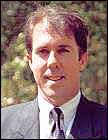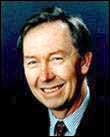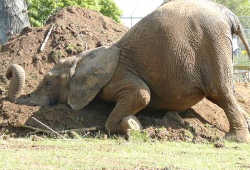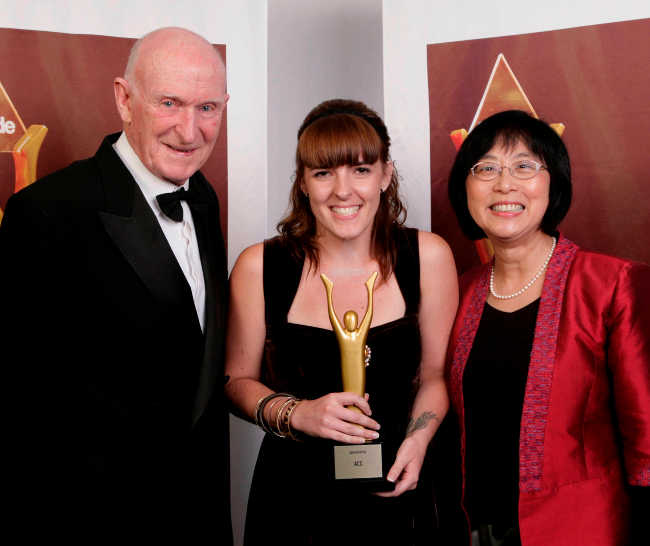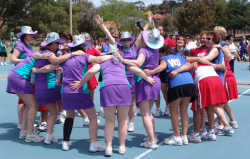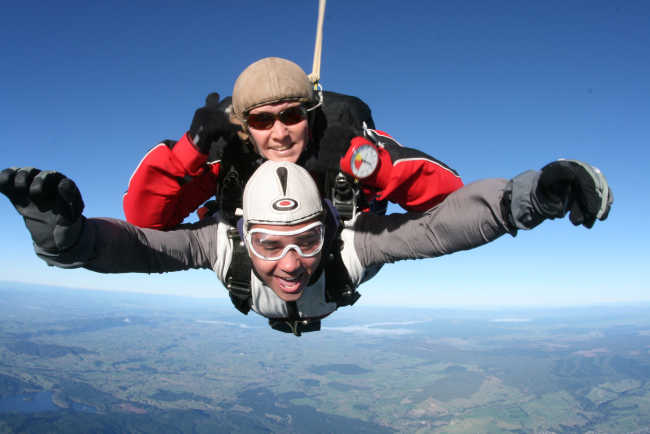Dorothy – 25/05/01

New Zealanders are complaining about the increases in their power bills and
after the recent drought conditions they are anxious about the low levels
in South Island lakes on which the large South Island hydro-electric power
stations depend for their water supply. The present government supports
the Kyoto Agreement and is making a push for renewable energy.
Americans are seriously concerned about their power shortages and President
George W. Bush’s plans for improving the power supply are upsetting
ecologists and conservationists.
What more appropriate time for launching Windflow Technology Ltd, a company
that will produce windmills for the development of electric power from the
wind and increase the electricity supply from an alternative source of
energy?
New Zealand an appropriate country New Zealand is located in the Roaring Forties and the airstream is
accelerated through narrow gaps in the mountains of the South and North
Islands, and sea breezes blow across its long coastlines. These factors
make this country an appropriate area for the development of windpower.
Expertise in engineering and in meteorology and wind energy
essential For Windflow Technology Ltd to succeed it needed a mechanical engineer
highly skilled in the design of the machinery involved, and a scientist
skilled in meteorology and knowledgeable about wind energy resources.
Fortunately in 1985 two people with these specialisations met when working
in the United States – Geoff Henderson engineer, and Neil Cherry
meteorologist.
|
|
Geoff Henderson |
Geoff Henderson Geoff Henderson’s ambition from his student days was to work in renewable
energy. After he graduated from the University of Canterbury with a
Bachelor’s Degree in mechanical engineering he worked for a consulting
engineer for three years on energy-related projects, and then was appointed
to manage a wind farm in the Altamont Pass in California – a dream come
true.
From there Geoff moved to work in England for the Wind Energy Group – the
leading firm in the field owned 50/50 by Taylor Woodrow and British
Aerospace. As a senior engineer he was responsible for the design and
development of wind energy technology and was project engineer for the
flagship machine MS3 which produced 300 kilowatts. It was a two-bladed
machine prototyped in 1987-88. His appointment to such a senior position
at such an early stage in this career reflected New Zealanders’ reputation
for being hard working and multi-skilled – both qualities needed in his
position.
A three-bladed machine developed previously had not been sufficiently
cost-effective and had been subject to wear and damage, but the two bladed
machine eradicated the fatigue loads.
|
|
Dr Neil Cherry |
Dr Neil Cherry Dr Cherry’s specialisation and experience fitted him ideally for
involvement in the development of Windflow. He was responsible for the
wind energy survey of New Zealand in the 1970s. At that time the
Government’s policy was to fund only the survey – their plan was that they
leave the development of the technology to overseas firms.
Neil was invited to review the United States wind energy programme run by
Battelle Laboratories, the leading group in the US wind survey programme.
His appointment was as an independent reviewer. In 1980 he spent six
months in Richland, Washington. Again there was a need for
multi-disciplinary skills as he was kept on at Battelle and asked to
correct previous research and extend the wind profiles.
At the end of 1991 the United States wanted to be world leaders in wind
research, and commissioned a World Survey of Wind Energy Resources.
Dennis Elliott had continental experience and surveyed the United States.
As Neil had experience in surveying winds over the oceans he did the rest
of the world. This research confirmed Neil’s belief that New Zealand had
massive potential for wind power development.
Modern wind turbines Modern wind turbines capture the wind’s energy by turning in the wind and
driving an electric generator. Modern windmills consist of:
| • | a rotor driving a generator generally through a gearbox |
| • | a tower |
| • | auxiliary systems including yawing, braking and hydraulics and often blade pitching and variable speed |
| • | a computerised controller |
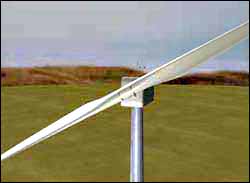 |
| Windflow Rotor |
The two-bladed Windflow windmill has the blades mounted on bearings so that
they can be “pitched” to control power and/or speed. In order to reduce
any imbalance in the wind forces on the two blades and therefore reduce the
stresses on the mechanisms the "teeter" hinge lets the rotor rock back and
forth. Importantly the blade pitching is coupled to the pitching motion
(through the pitch mechanism) so that the blade moving down-wind feathers
and the blade moving up-wind goes to fine pitch. This stablilises the
teeter motion.
The other important aspect of the design is the Torque Limiting Gearbox
which Geoff invented while he was working in England. It allows the rotor
speed to vary while keeping the torque constant. It provides a soft
connection to the grid to absorb the gust energy and send it smoothly into
the grid as it has a fluid step in it.
The use of the Torque Limiting Gearbox means that it does not have to be
designed to cope with the heavy loads carried by fixed speed machines.
This means that it saves money. Similarly the teetering rotor enables
lighter construction, which reduces costs. The design is more robust in
turbulence as it allows the rotor to move in response rather than resist
gusts.
Hydro power in New Zealand provides a backup Because the wind varies, a backup is needed and this normally limits the
amount of wind power that can be economically installed in an electrical
network or “grid”. In New Zealand lake water can be stored while wind
power is available and used in calm weather. This means that a higher
proportion of wind power can be used economically.
Wind power can be low cost energy If wind farms can be sited close to cities they avoid expense of long
cabling to connect with the hydro power. There are suitable windy sites
close to all the main centres in New Zealand which makes wind power a
source of low cost energy as the fuel is free and the line cost and the
energy losses are minimal.
Recent work in New Zealand Since Geoff returned to New Zealand he has been employed to survey wind
resources, and for several years he has been a consultant for The Power Co
Ltd in Southland.
Geoff and Neil were invited by ECNZ to participate in a research project
which led to the Brooklyn Wind Turbine in Wellington. ECNZ took a
conservative approach and wanted to use "proven technology and a guaranteed
manufacturer" for the machines and any needed repairs, so in 1993 they
imported from Denmark a machine developed in 1984-6.
Windflow machines will be manufactured in New Zealand For the Windflow machines the work will be done locally under sub-contract
by a Christchurch engineering firm and an Auckland boat builder, and will
use local expertise and factories already here. At present the windmills
operating in New Zealand are all imported – seven German mills in the
Wairarapa and 48 Danish mills near Palmerston North. Local production must
be beneficial for New Zealand, creating work for New Zealanders and saving
costs from shipping and the extra expense incurred with the present
exchange rate. Local manufacture also means local accountability and quick
cheap servicing.
The first site The first wind farm will be at Gebbies Pass close to Christchurch. The
site is in an area with highest mean winds in winter, when the spot price
for electricity is highest. There is a ten-year agreement with Orion to
connect to the network, and the Christchurch City Council has agreed to buy
all the output of the first turbine to cover the initial investment over a
long period.
The stages of development projected by Windflow Technology Ltd The first stage for Windflow Technology Ltd will be the building of one
windmill, the second stage the building of another ten, and the third
building up to sixty per year by year 5.
The use of wind power world wide as a source of energy grew six to
sevenfold in 1990-2000. With increasing interest in wind power in both New
Zealand and Australia the future for the production and sale of the
windmills looks promising, especially with CER facilitating trade with
Australia.
Investment in Windflow Technology Ltd The Company is seeking to raise three million dollars in the Stage 1
Offering. This offer closes on Friday, 1 June, 2001.
If you are interested in investing in the company go to
www.windflow.co.nz
and download the Investment Statement.
Neil Cherry as Chairman of Directors and Geoff Henderson as Director and
Chief Executive Officer and the other Board members were delighted to
receive a substantial investment from Teddy Goldsmith, the UK
environmentalist and founder of the Ecologist Magazine.
Those interested in preservation of New Zealand’s clean green image will
support the development of wind power as a source of renewable, clean and
competitive energy.

